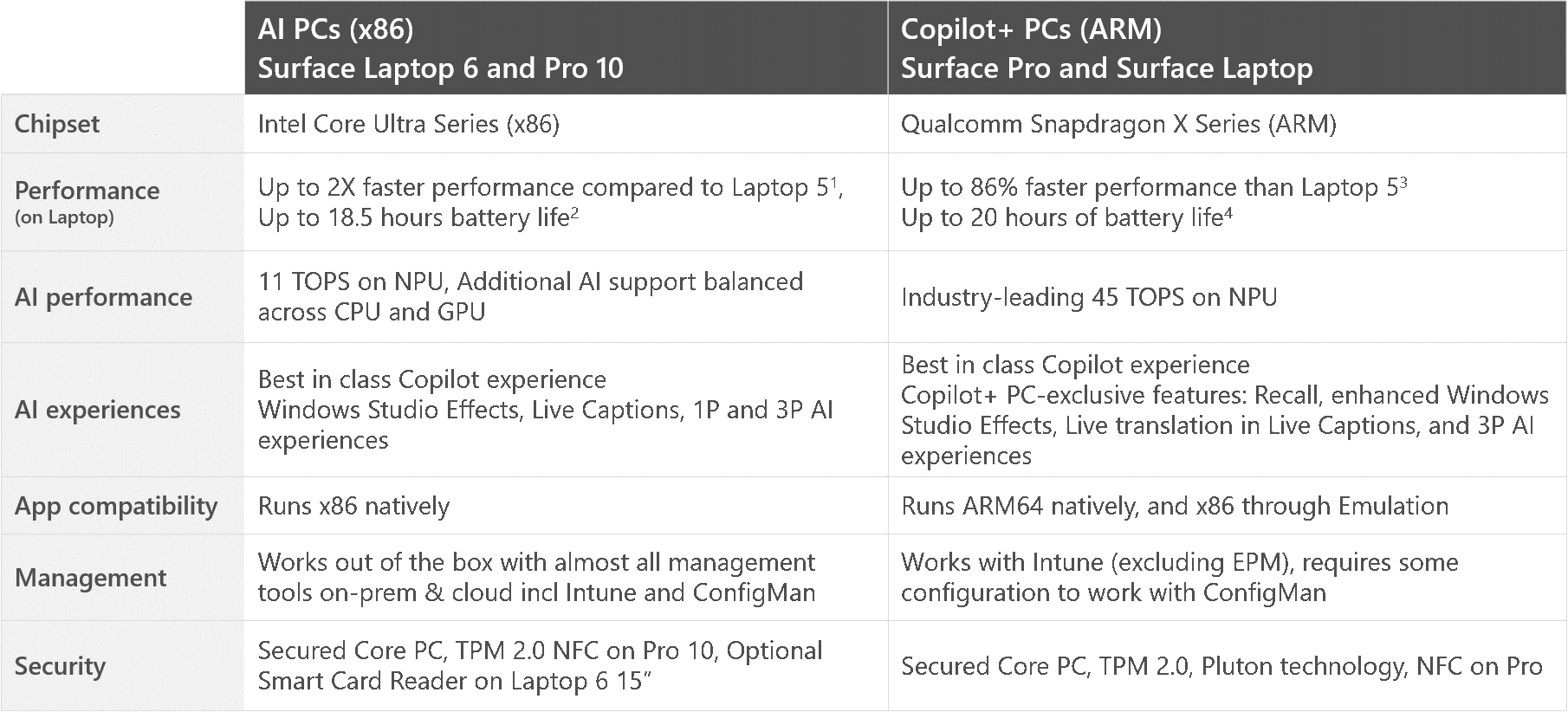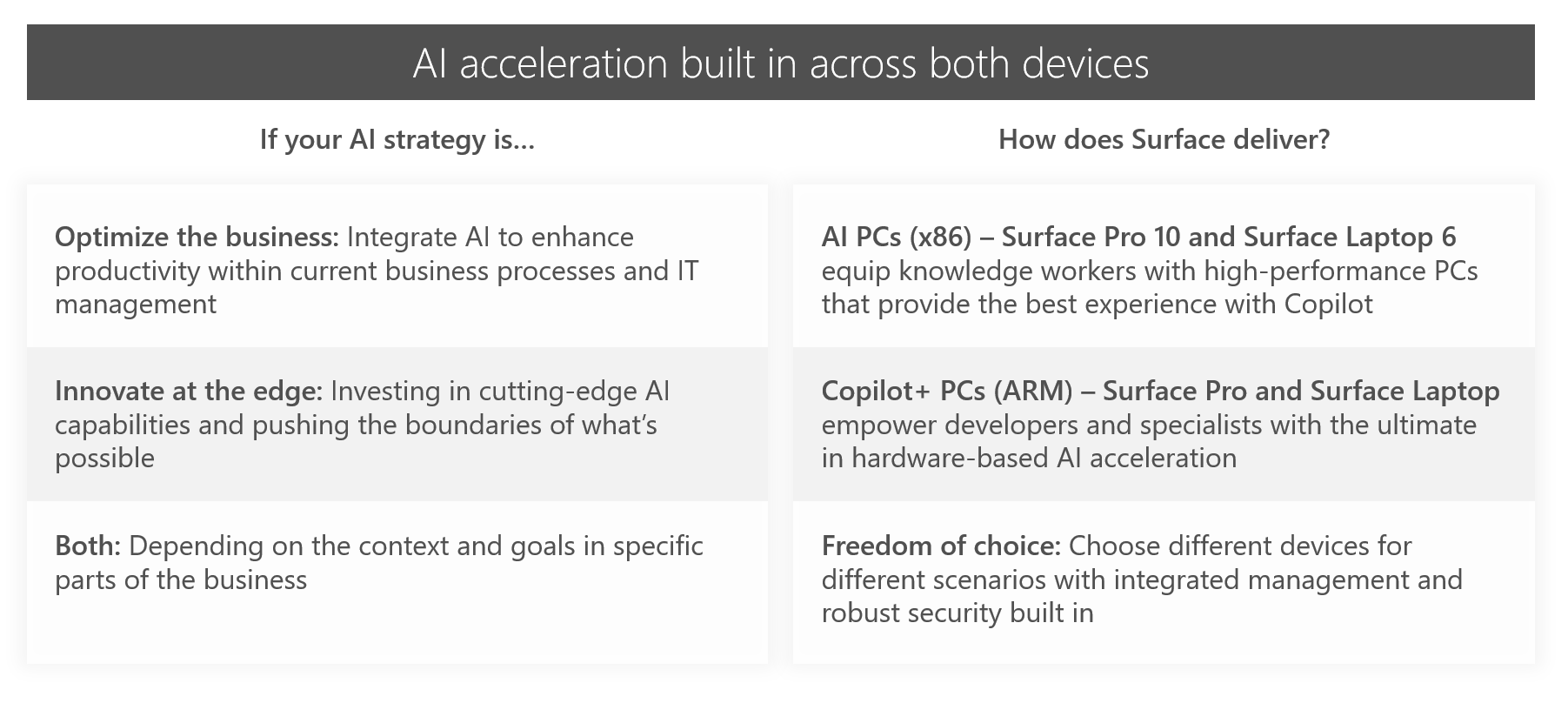AI on Microsoft Surface: Shaping the Future of Computing
11 November, 2024
The evolution of AI on Surface devices is a Microsoft journey that began long before the present day. Its early developments like the introduction of Battery Protection Mode in 2017, a feature that leveraged machine learning to optimise battery life by analysing how users interacted with their PCs. By 2019, Microsoft had started incorporating even more advanced AI features, such as eye gaze technology. These early adoptions of AI set the stage for more advanced innovations that continue to redefine the capabilities of Surface devices today.
A Seamless Experience: The Microsoft Advantage
One of the most significant advantages of Surface devices lies in Microsoft’s holistic approach to building every layer of the technology stack in-house. From the device itself, through AI capabilities, the operating system (OS), applications, cloud services, to the security layers and infrastructure, Microsoft’s control over the entire stack allows for a seamless, integrated experience. This comprehensive control is especially evident in the development of AI features like Copilot, which was rigorously tested to ensure it works optimally on Surface devices before being released to the broader market.
Insight: To get the best results from Copilot, high-quality input is essential. For example, using a basic Teams room system for transcription provided adequate results, but when switched to a Surface Pro 9 5G with an advanced processing unit, the difference was striking. The transcription quality and clarity improved significantly, highlighting that while Copilot works on any device, optimal performance comes from using the best input devices.
Surface Device Categories: AI PCs and Copilot Plus PCs
Today, Surface devices are categorised into two main types: AI PCs and Copilot Plus PCs.
- AI PCs, such as the Surface Pro 10 and Surface Laptop 6, incorporate Intel’s Neural Processing Unit (NPU). The NPU is specifically designed for AI workloads, offloading tasks from the CPU and GPU, which enhances efficiency and performance. For example, tasks like image recognition and voice processing are handled by the NPU with minimal latency, providing a smoother user experience without straining the main processing units.
Insight: The advantage of an NPU is particularly evident when you consider AI applications like Microsoft’s Paint demo, where users can draw a simple squiggle and instantly generate a detailed image, such as a mountain with trees, without requiring a cloud connection. This instantaneous processing with no latency is made possible by the NPU, offering a seamless experience that will continue to evolve as developers create new AI-driven applications.
- Copilot Plus PCs, like the Surface Pro 11th Edition and Surface Laptop 7th Edition, take a different approach. These devices utilise Qualcomm’s ARM-based processors, designed to meet Microsoft’s Copilot Plus PC specifications. These specifications include high-performance benchmarks such as 40 TOPS (trillion operations per second) and substantial memory and storage requirements, ensuring that Copilot Plus PCs deliver optimal AI-driven experiences. This makes them ideal for users who need powerful, AI-enabled computing on the go.

Practical AI Applications: Transforming Industries
The AI integration in Surface devices extends beyond enhancing performance, it’s about practical, real-world applications that make a difference in various industries. For instance, public safety dashcams now use AI to detect license plates in real time, even when offline. This capability significantly enhances operational efficiency by eliminating the need for constant internet connectivity and reducing latency. It’s a prime example of how AI can transform operations, making them more efficient and reliable.
Security and Privacy: A Microsoft Priority
While AI brings powerful capabilities to Surface devices, security and privacy remain paramount. Features like Windows Hello, which uses biometric authentication such as facial recognition, are designed to keep sensitive information local. This approach enhances security and privacy, as data is stored on the device rather than in the cloud. This is particularly important in environments where internet connectivity may be unreliable or data privacy is a critical concern.
On-device AI processing also reduces the need for cloud computing, which protects sensitive data and addresses cost and sustainability concerns. Cloud computing can be expensive and energy-intensive, so offloading AI tasks to on-device processors like NPUs or MPUs (Machine Processing Units) offers a more sustainable and cost-effective solution.
Innovations in AI: Enhancing User Experience
Surface devices are packed with AI-driven features designed to enhance the user experience. These include:
- Automatic Framing: The camera automatically adjusts to keep you centered as you move, providing a more professional appearance during video calls.
- Portrait Blur: This feature blurs the background, highlighting the subject, similar to the effects found on smartphone cameras.
- Eye Contact: AI subtly adjusts your eyes to appear as if you’re looking directly at the camera during video calls, improving engagement and communication.
- Voice Focus: Enhances audio clarity by isolating your voice and eliminating background noise, even in noisy environments.
- Live Captioning: Provides real-time captions for any video or content on the device without cloud support.
These features showcase the potential of on-device AI to improve performance and provide a more intuitive and engaging user experience.
The Future of Surface Devices: What’s Next?
Looking ahead, the Surface Pro 11th Edition, branded as a Copilot Plus PC, is set to be a game-changer in the market. Featuring Qualcomm Snapdragon chipsets like the Elite and Plus processors, this device can perform up to 45 trillion operations per second on its neural processing unit. Designed with commercial customers in mind, it includes features like a built-in NFC reader, up to 22 hours of battery life, multiple ports including USB-C, USB-A, and a headphone jack, and the latest wireless standards with Wi-Fi 7.
For businesses, the decision between AI PCs and Copilot Plus PCs will depend on specific needs. While Copilot Plus PCs offer advanced AI capabilities and high performance, AI PCs provide robust performance at a lower operational rate, which may be sufficient for many users.
The Surface Pro 11th Edition is just the beginning of what promises to be an exciting new chapter in AI-powered computing. With Synnex offering these devices to the channel, businesses will have access to the latest innovations in AI, setting a new standard for performance, efficiency, and user experience.
Which AI-enabled Surface is right for my business?

Overall, the combination of advanced processing units like the NPU, privacy-focused and sustainable AI solutions, sets the stage for a future where AI-driven experiences are more powerful, efficient, and widely accessible.
For further assistance in AI-enabled Surface devices, please contact our Surface team at 📩surface@au.synnex-grp.com.
Source and credit: Some content in this article is extracted from the ‘Get AI-ready with Surface’ webinar hosted by Synnex on 23 August 2024.



Leave A Comment